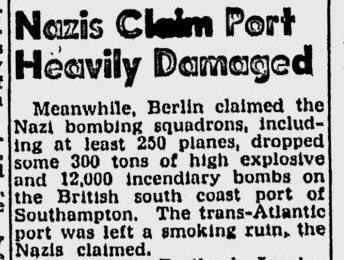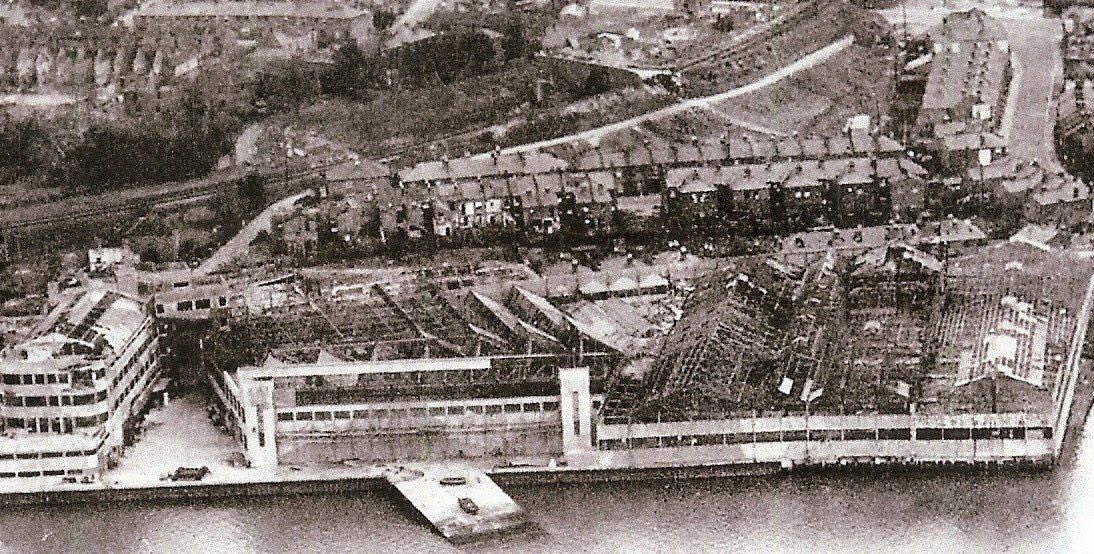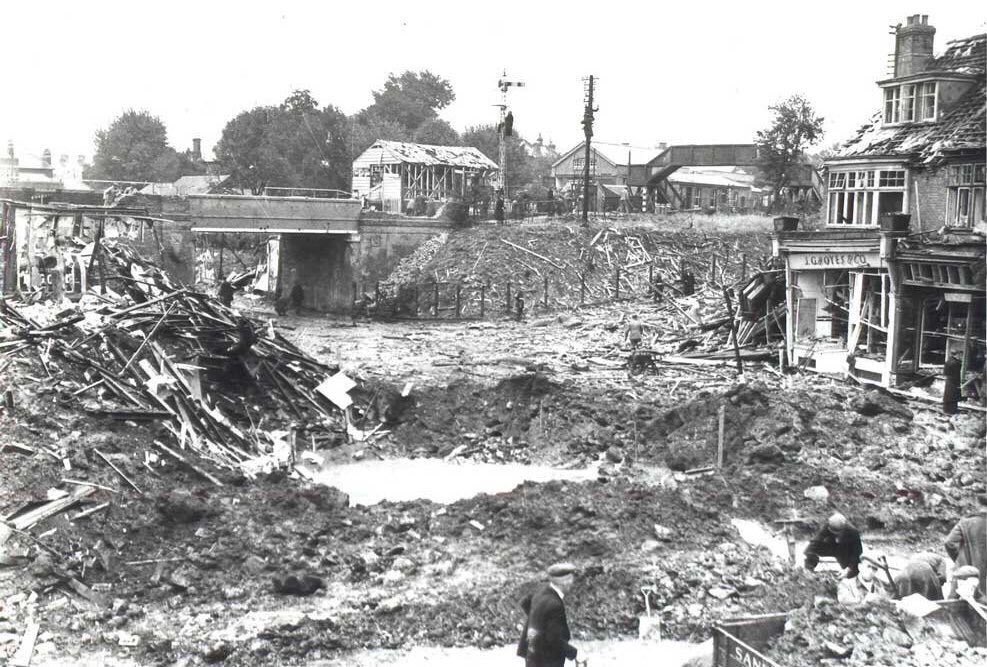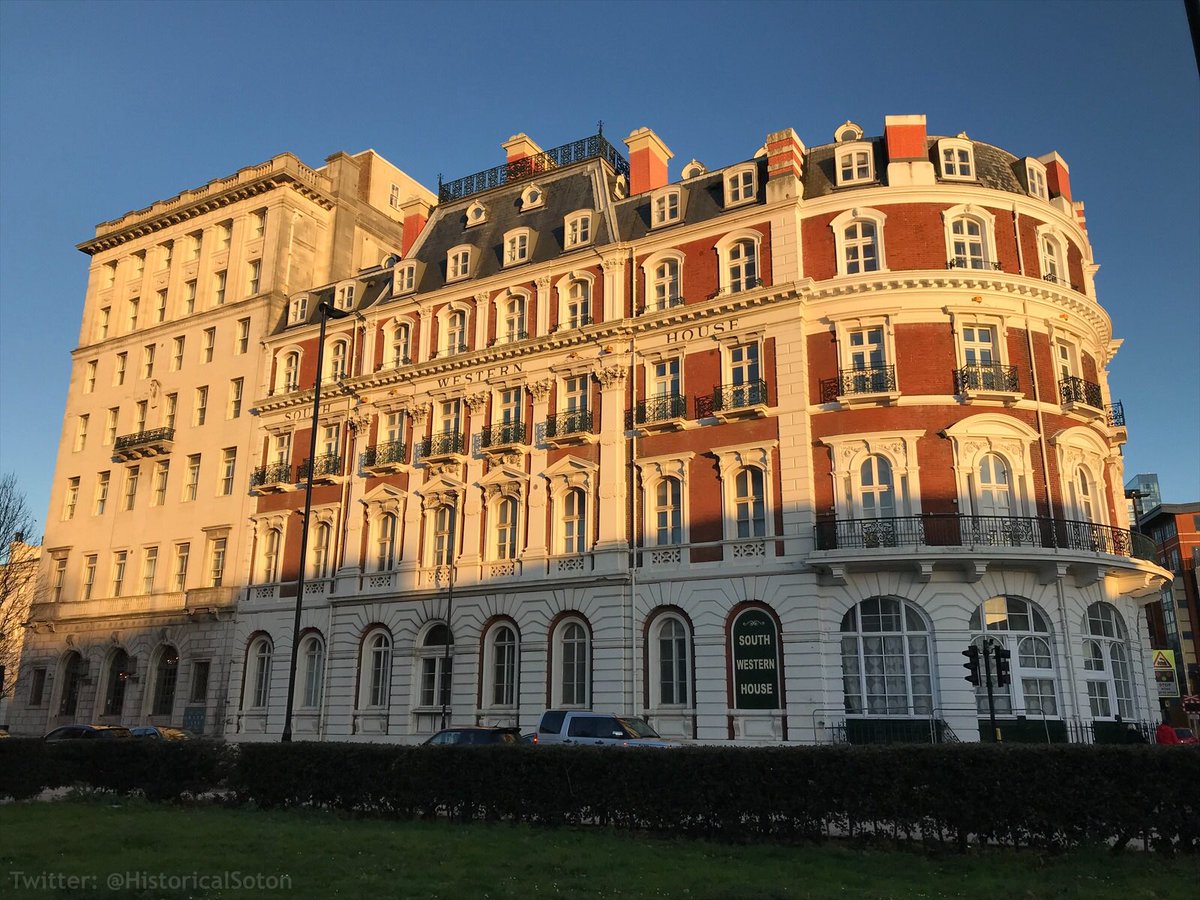
THREAD: THE SOUTHAMPTON BLITZ.
#OnThisDay eighty-one years ago - 23 November 1940 - the Luftwaffe targeted Southampton and the town suffered its most destructive raid of the Blitz so far.
According to American newspapers, the Nazis claimed Southampton was left a smoking ruin.
#OnThisDay eighty-one years ago - 23 November 1940 - the Luftwaffe targeted Southampton and the town suffered its most destructive raid of the Blitz so far.
According to American newspapers, the Nazis claimed Southampton was left a smoking ruin.

Southampton had already suffered many tragedies.
The Luftwaffe had marked out their main targets on an aerial photograph. These included the gas works at Northam and the Supermarine factory at Woolston. Over one hundred people died in raids on these targets in September 1940.
The Luftwaffe had marked out their main targets on an aerial photograph. These included the gas works at Northam and the Supermarine factory at Woolston. Over one hundred people died in raids on these targets in September 1940.

The Supermarine factory on the banks of the River Itchen at Woolston was notable for being the place where the Spitfire was designed and first built.
This image shows Bridge Road in Woolston after the nearby Supermarine factory was targeted in September 1940.
This image shows Bridge Road in Woolston after the nearby Supermarine factory was targeted in September 1940.

On 6 November 1940, the Civic Centre’s art gallery was bombed during a daylight air raid on Southampton.
Thirty-five people were killed. A class of fifteen children took shelter in the basement; only one child survived the direct hit.
There is a memorial inside the building.

Thirty-five people were killed. A class of fifteen children took shelter in the basement; only one child survived the direct hit.
There is a memorial inside the building.


Southampton was forced to endure many air raids throughout the Second World War. There are too many incidents to go into in one thread, so I’ll recommend some further reading later.
The 12th century Bargate was bricked up during the Second World War and used as an air raid shelter. Many of the town’s medieval vaults were also used as shelters.
Much of the surrounding area would be bombed but rather miraculously, the Bargate somehow survived.

Much of the surrounding area would be bombed but rather miraculously, the Bargate somehow survived.


The people of Southampton were used to blackouts and air raids by November 1940, although some people still ignored the rules. You can read about Southampton’s blackout here: historicsouthampton.co.uk/blackout/
In November 1940, the Nazis turned their attention to Southampton again…
In November 1940, the Nazis turned their attention to Southampton again…
At this very moment eighty-one years ago, a little after 6pm on 23 November 1940, the first bombs fell in what would become a sustained and brutal six hour raid on Southampton.
Lives were lost, entire areas were flattened, and fires raged throughout the night…
Lives were lost, entire areas were flattened, and fires raged throughout the night…
The Garibaldi Arms was destroyed #OnThisDay eighty-one years ago. Twenty-six people were killed here, including landlords Bert and Vera Reynolds. Only survivors were the Reynolds’ four children.
Titanic survivor Edgar Perry was killed. His wife, Martha, also died in this raid.
Titanic survivor Edgar Perry was killed. His wife, Martha, also died in this raid.

Bernard Street after the 23 November 1940 raid, compared to how it looked many years before the destruction of the Second World War. 



Southampton High Street during the Blitz in November 1940 and a similar view in November 2021.
The Red Lion pub can be seen here. It has been a pub since 1552 and, despite being damaged during the bombing, it’s still going today. Holyrood Church can be seen in the distance.

The Red Lion pub can be seen here. It has been a pub since 1552 and, despite being damaged during the bombing, it’s still going today. Holyrood Church can be seen in the distance.


During the raid #OnThisDay in 1940 the bombs continued to fall until around midnight.
It was reported that the red glow of Southampton burning could be seen from France.
The Luftwaffe would return the following week, with two huge raids over two consecutive nights…
It was reported that the red glow of Southampton burning could be seen from France.
The Luftwaffe would return the following week, with two huge raids over two consecutive nights…
This thread will be continued next week, to coincide with the date the Luftwaffe returned to Southampton: 30 November 1940.
Thanks for reading and I hope you will join me again next week.
Thanks for reading and I hope you will join me again next week.
30 November 1940.
#OnThisDay eighty-one years ago, on Winston Churchill’s sixty-sixth birthday, the Luftwaffe again targeted Southampton.
It had been a week since their last major raid and the town would suffer another terrible and tragic night of bombing during the Blitz.
#OnThisDay eighty-one years ago, on Winston Churchill’s sixty-sixth birthday, the Luftwaffe again targeted Southampton.
It had been a week since their last major raid and the town would suffer another terrible and tragic night of bombing during the Blitz.
At this very moment eighty-one years ago, at around 6pm on 30 November 1940, Southampton was lit up by German flares.
The air raid sirens began wailing and the first wave of Luftwaffe bombers dropped their high explosives and incendiary devices on to the town below...
The air raid sirens began wailing and the first wave of Luftwaffe bombers dropped their high explosives and incendiary devices on to the town below...
The 30 November 1940 raid lasted six hours.
Early on, twenty-five people were killed when a shelter on the High Street was hit. Gwen Hughes and her two children were the only survivors. The shelter became flooded and it took five hours for Gwen and her children to be rescued.
Early on, twenty-five people were killed when a shelter on the High Street was hit. Gwen Hughes and her two children were the only survivors. The shelter became flooded and it took five hours for Gwen and her children to be rescued.
After the rescue, Gwen was taken down Southampton High Street.
‘When I was being taken down the street a bomb exploded 50 yards (45 metres) behind me as well. We carried on and I remember the scenes to this day. The entire High Street was a huge wall of fire and flames.’
‘When I was being taken down the street a bomb exploded 50 yards (45 metres) behind me as well. We carried on and I remember the scenes to this day. The entire High Street was a huge wall of fire and flames.’
This incredible image appears in the ‘The World Aflame’, a remarkable book by @marinamaral2 and @dgjones. The photograph shows a woman being rescued in Southampton. Gwen Hughes and her children would have faced a similar ordeal and they were very lucky to survive. 

Southampton lost a number of churches during the Blitz.
Holyrood Church on Southampton High Street dated back to 1320. It was destroyed #OnThisDay in 1940.
The ruins now stand as a memorial to the Merchant Navy.
Holyrood Church on Southampton High Street dated back to 1320. It was destroyed #OnThisDay in 1940.
The ruins now stand as a memorial to the Merchant Navy.

Arthur Gledhill, an auxiliary fireman who also ran the Clarence pub near the church:
‘I remember the scene was as bright as day with the light from burning buildings. Holy Rood Church was ablaze from end to end, the spire was gone, the roof was gone… It was just a big inferno.’
‘I remember the scene was as bright as day with the light from burning buildings. Holy Rood Church was ablaze from end to end, the spire was gone, the roof was gone… It was just a big inferno.’
All Saints’ Church, which had stood on the corner of the High Street and East Street since 1795, was destroyed during the 30 November and 1 December raids.
There had been a church on this site since the twelfth century. Jane Austen worshipped here when she lived in Southampton.

There had been a church on this site since the twelfth century. Jane Austen worshipped here when she lived in Southampton.


Thankfully, so many of Southampton’s historic buildings did manage to survive and you can find out about some of them here: historicsouthampton.co.uk/old-town-walk/
Some buildings only received minor damage during the Blitz, such as the Star Hotel on Southampton High Street.

Some buildings only received minor damage during the Blitz, such as the Star Hotel on Southampton High Street.


The three raids in eight days exactly eighty-one years ago killed over two hundred people. Thousands of buildings and homes were damaged or destroyed. Much of Southampton‘s historic town centre was reduced to rubble and twisted metal.
Above Bar before and after the destruction.

Above Bar before and after the destruction.


One eyewitness later wrote: ‘It was as though the town had been the victim of a savage and brutal assassination.’
During these November raids, a public air raid shelter in Hoglands Park took a direct hit. An eyewitness estimated that around fifty people must have been inside and they simply did not stand a chance. Accounts of this particular tragedy are absolutely horrific. 

The @OrdnanceSurvey head office on London Road was bombed during the Blitz. A few years ago they made a map which shows where the bombs fell on Southampton during the two raids on 30 November and 1 December 1940. This doesn’t include 23 November and other raids during the war. 

On 2 December 1940, around 4,000 people left Southampton. Vans with loud speakers advertised evacuation. People packed their things into suitcases and prams and simply left. Many were homeless after the bombing raids. Hundreds lost more than just their homes.
© IWM ZZZ 8205C
© IWM ZZZ 8205C

In December 1940, just a few days after the worst nights of Southampton’s Blitz, King George VI visited the town.
He’s at the front of the group. This photograph was taken on Above Bar Street as he walked towards the Bargate. People shouted ‘God Save the King!’ as he passed.
He’s at the front of the group. This photograph was taken on Above Bar Street as he walked towards the Bargate. People shouted ‘God Save the King!’ as he passed.

In January 1941, Winston Churchill visited Southampton. On the steps of the Civic Centre, he addressed a crowd. “Are we downhearted?” he asked.
“No!” was the unyielding response. Their town had just been heavily bombed, but the people of Southampton showed incredible resilience.
“No!” was the unyielding response. Their town had just been heavily bombed, but the people of Southampton showed incredible resilience.

Despite the destruction the Blitz had brought to Southampton, life had to go on.
This photo shows Above Bar Street, which would have been lined with impressive buildings before the war.
This photo shows Above Bar Street, which would have been lined with impressive buildings before the war.

Some of the damage can be seen when comparing these two photos of the area around Southampton High Street.
The first was taken in 1933, and the second (courtesy of @SotonStories) was taken shortly after the end of WW2.
📸: britainfromabove.org.uk/image/epw042962
📸:

The first was taken in 1933, and the second (courtesy of @SotonStories) was taken shortly after the end of WW2.
📸: britainfromabove.org.uk/image/epw042962
📸:
https://twitter.com/sotonstories/status/1462728620682747912?s=21


Southampton was rebuilt after the war. However, it could be argued that although the austere post-war rebuild was contemporary and functional back then, the Blitz robbed the town of much of its character and charm.
East Street before the war and the same view in November 2021.

East Street before the war and the same view in November 2021.


This bench in Hollybrook Cemetery is a memorial to the civilians who were killed by enemy action in Southampton during the Second World War.
The back of the bench is made from the rubble of buildings destroyed during the Blitz.



The back of the bench is made from the rubble of buildings destroyed during the Blitz.




Ron Hunt was in Southampton as Nazi bombs pummelled the town. He sent some postcards to his parents back home in Godalming. Some of you may be interested in this article I wrote, in which I look at Ron’s postcards and Southampton’s Blitz: historicsouthampton.co.uk/postcards-from…
The Luftwaffe continued to target Southampton in 1941 and 1942. The German bombs brought yet more destruction and many more people were killed.
Despite being smashed, Southampton survived. Then, in June 1944, an extraordinary operation was launched from the battered port: D-Day.
Despite being smashed, Southampton survived. Then, in June 1944, an extraordinary operation was launched from the battered port: D-Day.
Most of those who took Gold and Juno beaches on D-Day embarked at Southampton.
Between D-Day and victory, 3.5 million Allied troops passed through the port.
The Nazis had tried to destroy Southampton, but Southampton later played a role in defeating the Nazis.
© IWM (A 23730)
Between D-Day and victory, 3.5 million Allied troops passed through the port.
The Nazis had tried to destroy Southampton, but Southampton later played a role in defeating the Nazis.
© IWM (A 23730)

Information about the air raids that Southampton suffered during the Second World War, as well as information about some of those who lost their lives, can be found here: sotonopedia.wikidot.com/page-browse:ai…
Thank you to everyone who took the time to read the thread, retweet, like, and comment. I really appreciate it.
One of my main sources was the excellent ‘Southampton’s Children of the Blitz’ by Andrew Bissell. The accounts by Gwen Hughes and Arthur Gledhill appear in this book.
One of my main sources was the excellent ‘Southampton’s Children of the Blitz’ by Andrew Bissell. The accounts by Gwen Hughes and Arthur Gledhill appear in this book.
If you would like to learn more, these are some other good books on the subject:
- ‘Southampton At War’ by Anthony Kemp.
- ‘The Southampton Blitz’ by Anthony Brode.
- ‘Southampton Blitz The Unofficial Story’ by Claire Frankland, Donald Hyslop, and Sheila Jemima.
END OF THREAD.
- ‘Southampton At War’ by Anthony Kemp.
- ‘The Southampton Blitz’ by Anthony Brode.
- ‘Southampton Blitz The Unofficial Story’ by Claire Frankland, Donald Hyslop, and Sheila Jemima.
END OF THREAD.
• • •
Missing some Tweet in this thread? You can try to
force a refresh














